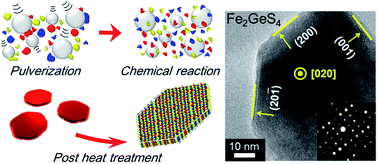Highly crystalline Fe2GeS4 nanocrystals: green synthesis and their structural and optical characterization†
Abstract
The olivine Fe2GeS4 compound has attracted much attention as a thermodynamically stable derivative of pyrite FeS2, which has been studied extensively as an earth-abundant light-absorbing candidate material. Nevertheless, reports on nanocrystalline Fe2GeS4 and its optoelectronic properties are limited. Herein, Fe2GeS4 nanocrystals are synthesized via a solvent-free mechanochemical process. This process not only reduces the synthesis time, but also avoids the use of hazardous solvents, thereby mitigating environmental concerns. The crystallinity of the synthesized nanocrystals is significantly enhanced by a post-heat treatment in a sulfur-containing atmosphere, showing no phase decomposition. Lattice-resolved micrographs reveal that the post-annealed nanocrystals have a hexagonal-faceted platelet structure with (002) base planes. The oxide layer near the surface region is removed by the post-annealing process, most likely due to the replacement of oxygen with sulfur in the controlled atmosphere. The post-annealed Fe2GeS4 nanocrystals clearly exhibit an optical band gap of 1.43 eV and near-band-edge photoluminescent emission at 1.41 eV. This is the first experimental demonstration of the Fe2GeS4 nanocrystals having optoelectronic properties that are suitable for solar applications.



 Please wait while we load your content...
Please wait while we load your content...